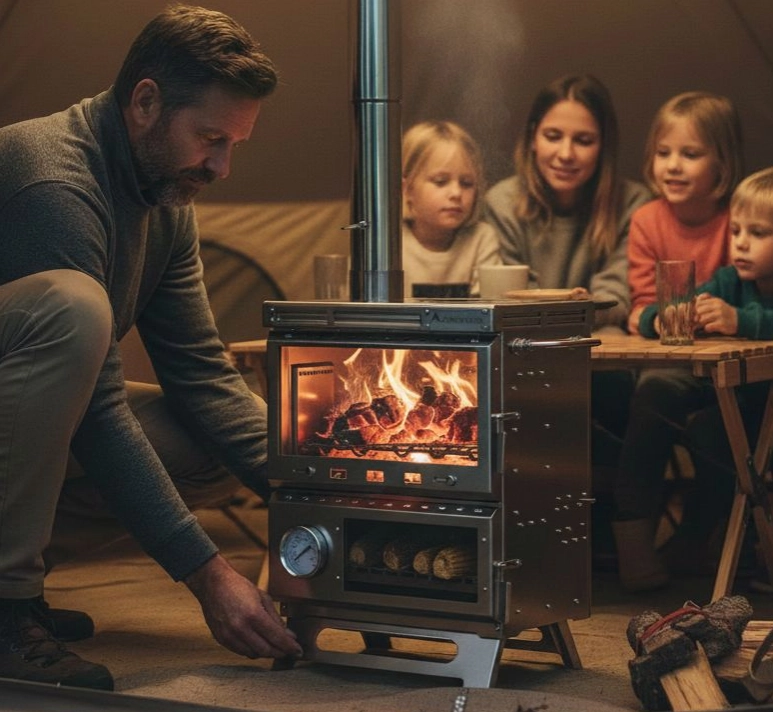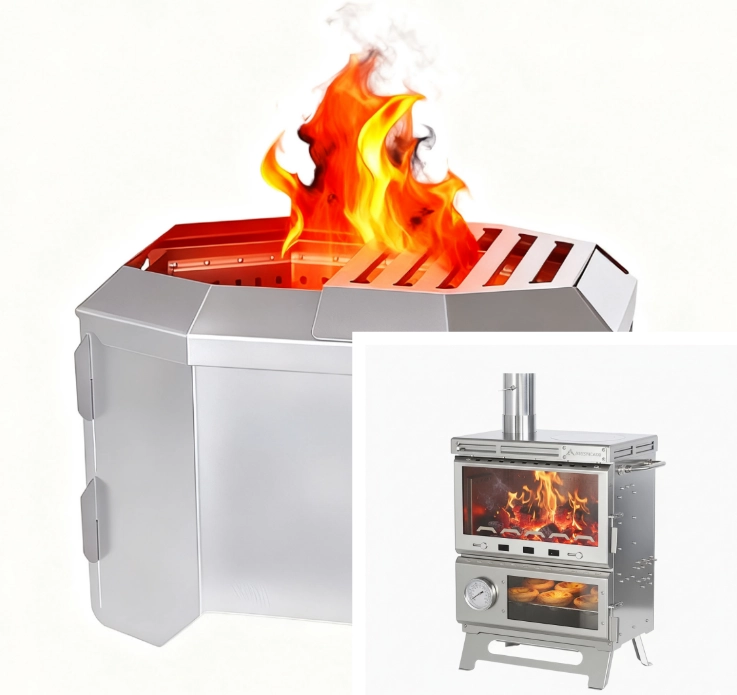Find out more about our news >
Gas Ignition vs. Traditional Charcoal: A Full-Spectrum Technical Analysis for Grill Manufacturers
In the rapidly growing outdoor cooking market, grill manufacturers face the critical decision of choosing between gas ignition and traditional charcoal systems—or designing hybrid solutions that combine the advantages of both. The choice impacts product performance, manufacturing processes, user experience, market positioning, and supply chain management.
For B2B buyers and outdoor brands, sourcing a high-quality grill means evaluating it from the inside out—from internal components and fuel systems to materials, design, safety, user experience, and even branding potential. Companies like Tuoshenghe, intelligent manufacturing experts in outdoor cooking equipment, provide ODM/OEM solutions that help brands deliver optimized, globally compliant grills.
This guide provides a comprehensive technical analysis of gas ignition versus traditional charcoal, covering all aspects that a grill manufacturer or B2B buyer should consider.
1. Internal Mechanics and Fuel System Technology
1.1 Gas Ignition Systems
Gas grills use propane, butane, or natural gas. Key internal components include:
Burners: Typically stainless steel or cast iron; responsible for even heat distribution.
Ignition Modules: Piezoelectric or electronic systems for reliable start-up.
Gas Valves and Regulators: Control flame intensity and maintain safety.
Heat Shields/Flavorizers: Protect burners and distribute heat evenly.
Technical Advantages:
Rapid ignition and temperature control.
Lower heat loss due to direct flame application.
Minimal smoke and cleaner combustion.
Considerations for Manufacturers:
Burner material selection to prevent corrosion.
Flame pattern uniformity for consistent cooking performance.
Integration of safety devices like gas leak detection and auto-shutoff systems.
1.2 Traditional Charcoal Systems
Charcoal grills rely on solid fuels and convection airflow. Core internal elements include:
Charcoal Grates: Hold the fuel above the ash pan.
Airflow Vents: Enable temperature regulation through oxygen control.
Ash Collection Systems: Ensure easy maintenance and prevent flare-ups.
Technical Advantages:
Generates high heat and rich smoky flavor.
Simple internal design with fewer failure points.
Considerations for Manufacturers:
Ventilation design impacts temperature stability.
Material heat resistance is crucial; carbon steel or ceramic inserts are common.
Efficient ash removal improves user experience and safety.

2. Heat Distribution and Cooking Performance
2.1 Gas Grills
Multi-zone burners allow simultaneous cooking at different temperatures.
Flame spreaders ensure uniform heat across grates.
Ideal for consistent cooking of delicate items like vegetables and fish.
2.2 Charcoal Grills
Heat distribution is less uniform; skillful charcoal placement is required.
High-heat zones are perfect for searing meat.
Convection airflow can be optimized through vent placement and grill geometry.
Hybrid Consideration: Manufacturers increasingly design dual-fuel grills that allow users to combine rapid ignition with charcoal flavor, leveraging the strengths of both systems.
3. Material Selection and Structural Engineering
Material choice affects weight, portability, durability, and user safety.
Fuel Type | Common Materials | Engineering Considerations |
Gas | Stainless steel, aluminum, cast iron | Burners and housing must resist corrosion, warping, and thermal fatigue |
Charcoal | Carbon steel, stainless steel, ceramic | Grates and bodies must withstand prolonged high heat; ceramic adds flavor retention |
Hybrid | Combination of above | Must balance weight, heat retention, and portability |
Additional structural considerations:
Insulation: For efficient heat retention and user safety.
Portability Design: Foldable legs, detachable handles, and lightweight materials improve transport.
Maintenance Accessibility: Easy removal of ash trays, burners, and grates.
Suppliers like Tuoshenghe optimize internal engineering and material combinations to ensure durability and cost-efficiency.
4. Safety Systems and Compliance
Safety is essential for both fuel types but manifests differently:
4.1 Gas Grills
Flame guards, heat shields, and anti-flare mechanisms.
Gas leak detectors and automatic shutoff valves.
Compliance with CE, UL, or GS certifications for international markets.
4.2 Charcoal Grills
Stable tripod or base designs to prevent tipping.
Heat-resistant handles for safe operation.
Proper ash and ember containment systems to prevent accidental fires.
Manufacturers must design safety into the grill from the start, integrating safety with functionality and aesthetics.
5. User Experience and Maintenance
User experience drives repeat purchases and brand loyalty:
Gas Grills: Easy ignition, precise temperature control, minimal cleaning required. Ideal for casual or urban campers.
Charcoal Grills: Requires skill to manage airflow and fuel placement, but offers unmatched flavor for enthusiasts.
Hybrid Grills: Combines convenience and traditional taste, appealing to a broader market segment.
Maintenance considerations for manufacturers: removable grates, ash pans, and modular components improve user satisfaction.
6. Market Trends and Consumer Preferences
Hybrid Models Rising: Consumers seek flexibility and convenience.
Portability: Lightweight, foldable gas grills attract urban and mobile campers.
Eco-Friendly Trends: Consumers prefer low-emission fuels and recyclable materials.
Customization: Users demand grills tailored to their camping style, from small portable grills to backyard setups.
Manufacturers must integrate these trends into design, fuel system choice, and marketing strategy.

7. Supply Chain and Manufacturing Considerations
B2B buyers must evaluate suppliers on:
Experience: 15+ years in outdoor equipment, like Tuoshenghe, ensures technical know-how.
ODM/OEM Capability: Customizable fuel systems, cooking zones, accessories, and branding.
Production Capacity: Ability to meet high-volume orders reliably.
Quality Assurance: Pre-shipment inspection, testing for heat distribution, ignition reliability, and safety compliance.
Logistics Support: Global delivery and warranty management.
Reliable suppliers reduce risks of product defects, delays, and non-compliance.
8. Brand Differentiation and Customization
Visual Identity: Logo placement, color options, and aesthetic design.
Functional Customization: Modular hybrid fuel systems, adjustable grates, and accessory compatibility.
Packaging: Retail-ready, bulk, or premium packaging for e-commerce or physical retail.
Tuoshenghe provide flexible solutions that allow brands to differentiate their products and target multiple market segments effectively.
9. Technical Comparison Table
Feature | Gas Ignition | Charcoal | Hybrid |
Ignition | Electronic/piezo | Manual | Both |
Heat Control | Precise | Indirect via vents | Multi-zone control |
Flavor | Cleaner | Smoky | Customizable |
Maintenance | Low | Moderate | Moderate |
Safety | Gas leak detection | Stable base, heat handles | Combination |
Material | Stainless steel, aluminum, cast iron | Carbon steel, ceramic | Mixed |
Market Appeal | Casual campers, urban | Enthusiasts, backyard | Broad audience |
10. Conclusion
For grill manufacturers, choosing between gas ignition, traditional charcoal, or hybrid systems is a strategic decision that impacts:
Design and engineering
Material selection and durability
Safety and compliance
User experience and maintenance
Market positioning and branding
Collaborating with experienced suppliers like INBESTCAMP ensures optimized designs, reliable production, and tailored ODM/OEM solutions for global outdoor brands. By evaluating grills from internal mechanics to external market positioning, manufacturers can deliver high-quality products that satisfy diverse consumer needs and maximize profitability.




 RELATED MAGAZINE
RELATED MAGAZINE 












